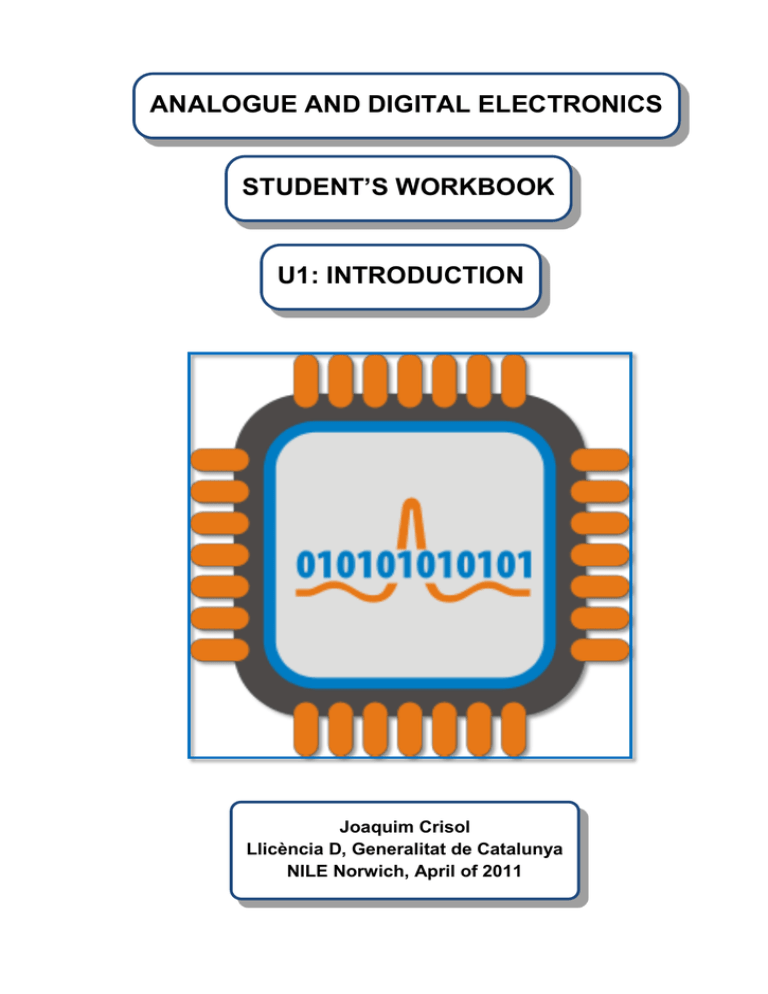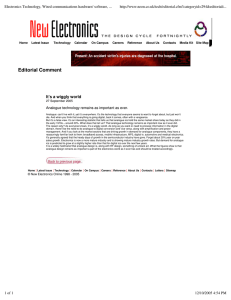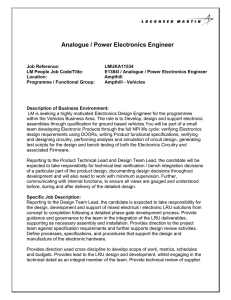student`s workbook analogue and digital electronics u1: introduction
advertisement

ANALOGUE AND DIGITAL ELECTRONICS STUDENT’S WORKBOOK U1: INTRODUCTION Joaquim Crisol Llicència D, Generalitat de Catalunya NILE Norwich, April of 2011 Electronics Table of contents Table of contents 1 INTRODUCTION TO ELECTRONICS. ..................................................................... 2 1.1 Electricity and electronics. .................................................................................. 2 1.2 Past, present and future of electronics. .............................................................. 3 1.3 From analogue to digital electronic systems. ...................................................... 6 Student’s workbook Page 1 Electronics 1- Introduction. 1 INTRODUCTION TO ELECTRONICS. 1.1 Electricity and electronics. 1 Do you know the names of these objects? 2 Complete the definitions of electronic and electrical technology. Electrical technology energy Electronics ____________ is the branch of science and ____________ that deals with electrical circuits applied to information and signal processing. ____________ technology deals with the generation, distribution, switching, storage and conversion of electrical ____________. Student’s workbook Page 2 Electronics 3 1- Introduction. Classify the objects from the first activity as electrical or electronic. Electrical Electronic When you finish, check the answers with your partner. Don't look at their answer. You can use these models. Is a light bulb an electronic or electrical device? I think it is an electric device because it converts electric energy. I think it is an electronic device because it processes information. 1.2 Past, present and future of electronics. 4 Match these pictures with their names and definitions. Transistors Integrated circuits Vacuum tubes Student’s workbook A miniaturized electronic circuit manufactured on a substrate of semiconductor material. A device used to amplify and switch electrical signals by controlling the movement of electrons in a low-pressure tube. A solid semiconductor device used to amplify and switch electronic signals. Page 3 Electronics 5 1- Introduction. Find out what year these things happened by reading the text below. a) _ _ _ _ Invention of the vacuum tube. d) _ _ _ _ Start of radio broadcasting. b) _ _ _ _ Invention of the transistor. e) _ _ _ _ Start of black and white television. c) _ _ _ _ First microchip. f) _ _ _ _ First mobile phone in your family. Place them on the timeline. a) 1900 1920 1940 1960 1980 2000 Summary of the history of electronics Electronics originated from electrical science at the beginning of the 20th century. In 1883, Thomas Alva Edison discovered the thermionic effect. Electrons flow from one metal conductor to another through a vacuum. In 1904, T. A. Fleming built the first vacuum tubes. These devices can amplify electrical signals. The first applications of electron tubes were in radio communications. Vacuum tubes made weak audio signals from radio waves stronger. Radio broadcasting grew in the 1920s. Development of the television benefited from many improvements made to radar during World War II. Television became widely available in 1947. After the war, electron tubes were used to develop the first computers, but they were impractical because of the sizes of the electronic components. In 1947, the transistor was invented by a team of engineers from Bell Laboratories. The transistor works like the vacuum tube, but it is smaller, consumes less power, is much more reliable, and is cheaper. Around 1960, the first integrated circuits were made. Integrated circuits are also called microchips, or IC. The typical IC consists of resistors, capacitors, and transistors packed on a single piece of silicon. Microcomputers, microwave ovens and mobile phones are examples of devices made possible by integrated circuits. Student’s workbook Page 4 Electronics 1- Introduction. In 1971, INTEL manufactured the first microprocessor with 2300 transistors. By 2009, the number of transistors in some microchips was more than 10 billion. At the moment, scientists are working on molecular electronics, optical and quantum computing. These and other emerging technologies will bring developments that we cannot imagine. 6 Fill in the gaps with data from the text above. Date Invention Applications 1904 Transistor 1960 Be ready to answer following this model: The microprocessor was invented in 1971. Its applications are …. 7 Look at these pictures and listen to the text. Then answer the questions below. Student’s workbook Page 5 Electronics 1- Introduction. a) What is e-waste? E-waste is … b) Where does most e-waste go? Most e-waste is exported to … c) Do you think e-waste is toxic? ................................................................... because electronic products contain heavy metals such as lead and mercury and hazardous chemicals. d) E-waste will be a bigger problem in the future because more and more people use more and more electronic devices and change them more often. Talk to your partner and try to find a solution to the e-waste problem. Governments should ... We all should ... Electronic products should ... 1.3 From analogue to digital electronic systems. You already know that the function of an electronic system is to process information. Any electronic device can be thought of as three linked parts – input, process, output. In electronics we use a block diagram to represent the parts of a system. INPUT PROCESS OUTPUT 1. The input part takes in energy of some form and produces an electrical signal. 2. The process part modifies or does some calculations with the electrical signal. 3. The output part produces a new energy output from the processed electrical signal. Student’s workbook Page 6 Electronics 8 1- Introduction. Label the objects by using the language bank below and identify the input and output block for each one. Megaphone Input Process Output MICROPHONE ELECTRONICS LOUDSPEAKER It converts sound to electrical signals. It processes electrical signals. It converts electrical signals to sound. ELECTRONICS _______________ _______________ ______________ It processes electrical signals. ________________ ________________ _______________ ELECTRONICS _______________ _______________ ______________ It processes electrical signals. ________________ ________________ _______________ ELECTRONICS _______________ _______________ ______________ - Aerial It processes electrical signals. - Digital thermometer ________________ ________________ ______________ -Loudspeaker Loudspeaker - Senses changes in temperature and produces an electrical signal - Takes in electromagnetic waves and produces an electric signal - Calculator - It transforms electrical signals to sound - Push-buttons that generate electric signals - Display screen - keypad - It gives a readout of temperature - Temperature display - It converts electrical signals to visible - Temperature sensor numbers screen - Radio Student’s workbook Page 7 Electronics 1- Introduction. Check answers with your partner and be ready to answer following this pattern. Object number 1 is a megaphone. The microphone converts sound to electrical signal. This signal is processed by the electronics and then the loudspeaker converts it to sound. Electronic signals can be analogue or digital. 9 An ANALOGUE signal continually changes and can have any value in a given range. A DIGITAL signal can only have certain, discrete values. DIGITAL BINARY signals are a subgroup of digital signals that can have only two states, ON (1) or OFF (0). There are no values in between. Label these signals as analogue, digital or digital binary. signal signal time time Match the sentences with arrows. The dashed signal is The continuous signal is The dotted signal is Student’s workbook digital binary analogue digital because it has any value. because it has only two values because it has only certain values. Page 8 Electronics 10 1- Introduction. We can think of objects as analogue or digital. Can you write the names of the following objects in the diagram? analogue 1) 2) digital d_ _ _ _ ay binary th _ _ _ _ _ et_ _ 3) s_ _ _ _ h Check the answers with your partner. It is a.... I think it is............ because ..... What do you call object 1? Is it analogue or digital? Why? 11 The following text about noise has some blanks. Your teacher will give you a text with half of the gaps filled in. Your partner will have the other half. 1. Copy them into your workbook. 2. Now dictate to each other to complete the text. 3. Agree on a heading for the text. HEADING:____________________________________________________ Signals in nature are analogue. For example_____________________________(a). It is analogue because it can be any value. ______________________________________ (b): They can be converted to numbers and easily ________________________ (a). They are easy to store and to compress using mathematical algorithms. Noise ________________________ (b) as much as to analogue signals. When data is transmitted, processed or stored a certain amount of NOISE ________ ____________________ (a). Student’s workbook Page 9 Electronics 1- Introduction. With an analogue signal, noise cannot be _______________________________ (b) . We have distortion. In a digital signal, noise will not matter, as any signal close enough to a particular value will be interpreted as that value. Draw the original signal in colour. time time Which one is more difficult to rebuild? The ....................... signal is easier to reproduce because it can have only ..........................values. 12 Listen to the text about the analogue-digital conversion process. Fill in the gaps and answer the final question. Analogue signals are processed by analogue __________ and digital signals are processed by __________ circuits. In between, we can use these electronic circuits to _____________ from analogue to digital and vice versa. ADC: analogue-to-digital converters DAC: digital-to-analogue converters …001010101010111111…. Analogue INPUT ADC Digital PROCESS OR STORAGE DAC Analogue OUTPUT For example, we can get ___________ with a microphone and analogue electronics. Then an ADC converts this signal to digital __________. This data can be __________ and stored in a digital format, such as ________. Home electronics used to be analogue but nowadays everything is mainly digital. So, we have digital TV, digital photography, digital ____________, etc. Student’s workbook Page 10 Electronics 1- Introduction. Circle the right answer: a) b) c) d) 13 DAC stands for analogue-digital-conversion. Modern electronics is mostly digital. To play mp3 music we have to use a DAC. Sound is a digital signal. Decide if these sentences are true or false. If they are false change them so that they are true. T / F A cassette tape is the digital evolution of a CD (compact disc). .................................................................................................. T / F DVB (digital video broadcasting) has no noise because it is an analogue signal. ........................................................................... T / F Analogue photography can be easily modified, compressed and transmitted. .......................................................................................................................... T / F An ADC converts digital signals to analogue. ....................................................................... T / F Digital electronic systems are older than analogue systems. ............................................................................................... T / F All digital signals are binary signals. ......................................................... Self assessment: In the next unit you are going to learn more about analogue electronic circuits. Before you move on make sure that you can answer yes to these questions. QUESTION No More or less Yes Can I order the main developments in electronics and say what decade they happened? Do I know what problems e-waste can cause and how to avoid them? Can I draw a block diagram for a basic electronic system? Can I give examples of analogue, digital and binary signals? Can I compare analogue and digital systems? Student’s workbook Page 11



